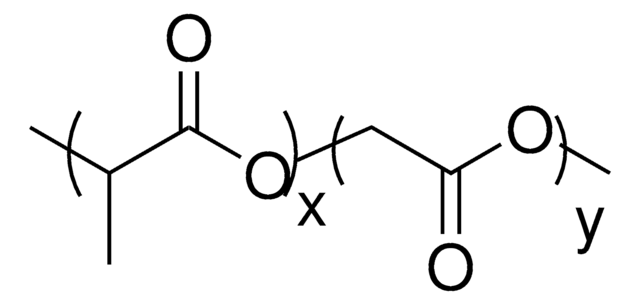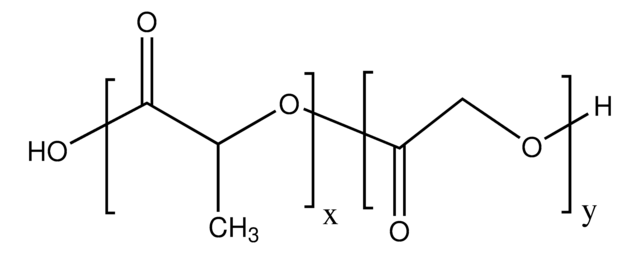908630
Poly(lactide-co-glycolide)-Flamma Fluor near-IR
lactide:glycolide (50:50), Mn 20,000-30,000
Synonym(e):
PLGA near IR, PLGA-FPI749, near IR conjugated PLGA
Anmeldenzur Ansicht organisationsspezifischer und vertraglich vereinbarter Preise
Alle Fotos(1)
About This Item
Lineare Formel:
(C3H4O2)x(C2H2O2)y
UNSPSC-Code:
12162002
NACRES:
NA.23
Empfohlene Produkte
Form
powder or chunks
Zufuhrverhältnis
lactide:glycolide (50:50)
Mol-Gew.
Mn 20,000-30,000
average Mn 20,000-30,000
Zusammensetzung
Dye Content, 7.54 μg/mg (polymer)
Farbe
blue to teal
Lagertemp.
−20°C
Anwendung
Poly(lactide-co-glycolide)-Flamma Fluor near-IR is labelled with Flamma Fluor FPI749 near-IR dye. It can be used in the formation of fluoresent nanoparticles for in-vivo imaging applications.
Lagerklassenschlüssel
11 - Combustible Solids
WGK
WGK 3
Flammpunkt (°F)
Not applicable
Flammpunkt (°C)
Not applicable
Hier finden Sie alle aktuellen Versionen:
Analysenzertifikate (COA)
Lot/Batch Number
Leider sind derzeit keine COAs für dieses Produkt online verfügbar.
Wenn Sie Hilfe benötigen, wenden Sie sich bitte an Kundensupport
Besitzen Sie dieses Produkt bereits?
In der Dokumentenbibliothek finden Sie die Dokumentation zu den Produkten, die Sie kürzlich erworben haben.
Fanfei Meng et al.
ACS nano, 12(7), 6458-6468 (2018-06-20)
Fluorescence-based whole-body imaging is widely used in the evaluation of nanoparticles (NPs) in small animals, often combined with quantitative analysis to indicate their spatiotemporal distribution following systemic administration. An underlying assumption is that the fluorescence label represents NPs and the
Yihan Xu et al.
Journal of biomedical materials research. Part B, Applied biomaterials, 105(6), 1692-1716 (2016-04-22)
Poly (lactic-co-glycolic acid) (PLGA) copolymers have been broadly used in controlled drug release applications. Because these polymers are biodegradable, they provide an attractive option for drug delivery vehicles. There are a variety of material, processing, and physiological factors that impact
R Gref et al.
Science (New York, N.Y.), 263(5153), 1600-1603 (1994-03-18)
Injectable nanoparticulate carriers have important potential applications such as site-specific drug delivery or medical imaging. Conventional carriers, however, cannot generally be used because they are eliminated by the reticulo-endothelial system within seconds or minutes after intravenous injection. To address these
Unser Team von Wissenschaftlern verfügt über Erfahrung in allen Forschungsbereichen einschließlich Life Science, Materialwissenschaften, chemischer Synthese, Chromatographie, Analytik und vielen mehr..
Setzen Sie sich mit dem technischen Dienst in Verbindung.






